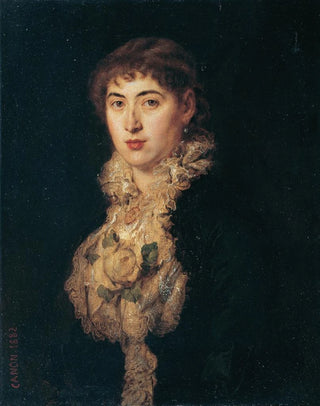Art print | Maria Baronne von Zehmen - Hans Canon


View from behind

Frame (optional)
The artwork "Maria Baronne von Zehmen" by Hans Canon is a true testament to the exceptional talent of this 19th-century artist. This portrait, which captures the very essence of its subject, immerses us in a universe where delicacy and psychological depth meet. The baroness, an iconic figure of Viennese nobility, is depicted with an elegance that transcends time. Canon, a master of light and shadow, manages to breathe palpable life into his model, making this painting timeless and captivating. Through this work, we discover not only a faithful representation of a woman from her era but also an invitation to explore the subtleties of human psychology.
Style and uniqueness of the work
Hans Canon's style is distinguished by his ability to combine realism and romanticism. In "Maria Baronne von Zehmen," every detail is carefully crafted, from the textures of the clothing to the nuances of the skin. This meticulous attention gives the baroness an almost living presence, as if she could come to life and address the viewer. The colors, subtly chosen, evoke an atmosphere that is both intimate and majestic, reinforcing the unique character of this work. The background, often blurred, highlights the main subject, creating a striking contrast that immediately draws the eye. This stylistic choice perfectly illustrates Canon's mastery in directing the viewer's attention while allowing them to feel the emotion conveyed by the portrait.
The artist and his influence
Hans Canon, born in 1820 in Vienna, established himself as one of the most prominent portraitists of his time. His training with great masters and his immersion in the artistic currents of his era shaped his unique approach. Canon was influenced by realism but also incorporated elements of romanticism, enabling him to create works of great emotional depth. His ability to capture the personality of his subjects and depict them with remarkable fidelity made him a preferred choice for Vienna's high society. Furthermore, his work inspired many contemporary and future artists, who saw in him a role model to follow.

Matte finish

View from behind

Frame (optional)
The artwork "Maria Baronne von Zehmen" by Hans Canon is a true testament to the exceptional talent of this 19th-century artist. This portrait, which captures the very essence of its subject, immerses us in a universe where delicacy and psychological depth meet. The baroness, an iconic figure of Viennese nobility, is depicted with an elegance that transcends time. Canon, a master of light and shadow, manages to breathe palpable life into his model, making this painting timeless and captivating. Through this work, we discover not only a faithful representation of a woman from her era but also an invitation to explore the subtleties of human psychology.
Style and uniqueness of the work
Hans Canon's style is distinguished by his ability to combine realism and romanticism. In "Maria Baronne von Zehmen," every detail is carefully crafted, from the textures of the clothing to the nuances of the skin. This meticulous attention gives the baroness an almost living presence, as if she could come to life and address the viewer. The colors, subtly chosen, evoke an atmosphere that is both intimate and majestic, reinforcing the unique character of this work. The background, often blurred, highlights the main subject, creating a striking contrast that immediately draws the eye. This stylistic choice perfectly illustrates Canon's mastery in directing the viewer's attention while allowing them to feel the emotion conveyed by the portrait.
The artist and his influence
Hans Canon, born in 1820 in Vienna, established himself as one of the most prominent portraitists of his time. His training with great masters and his immersion in the artistic currents of his era shaped his unique approach. Canon was influenced by realism but also incorporated elements of romanticism, enabling him to create works of great emotional depth. His ability to capture the personality of his subjects and depict them with remarkable fidelity made him a preferred choice for Vienna's high society. Furthermore, his work inspired many contemporary and future artists, who saw in him a role model to follow.






